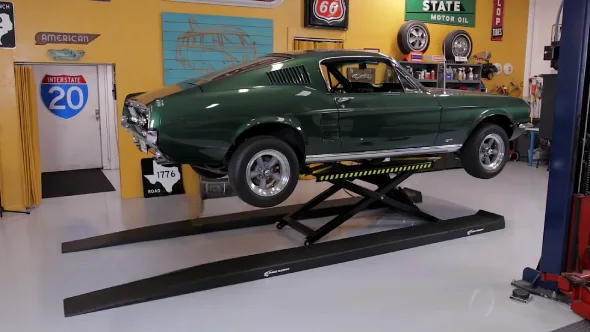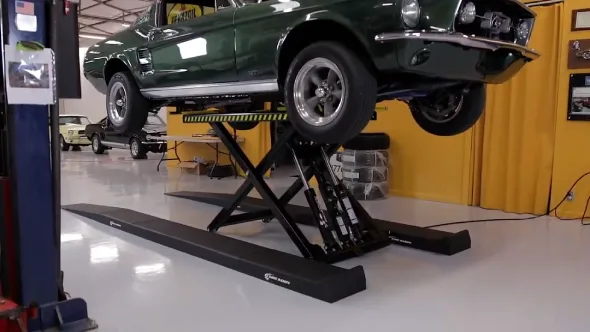Last Updated on March 21, 2023
A scissor jack is an affordable and convenient tool to help you raise your vehicle off the ground. This tool can be used to rotate or change tires and as an emergency roadside repair tool. But can you use a scissor jack to lift up your car efficiently? It’s possible, but with some guidelines.
Scissor jacks allow you to lift your car and access any part that needs repairs or servicing from underneath. You only need a level spot to park your vehicle and the jack. Once you’ve located the jacking spot on your vehicle, simply place the jack in position and spin the handle until it starts lifting your car.
You can add additional support by placing jack stands beneath your vehicle once it’s lifted far enough. Whether performing routine maintenance or needing an emergency roadside repair tool, this guide shows how to lift a car using a scissor jack safely.
Can I Use an RV Scissor Jack to Lift My Car?

RV scissor jacks can lift your car for simple tasks such as changing a flat tire or performing an emergency roadside repair. But they are not designed for heavy-duty lifting or other more complex tasks involving higher levels of weight and pressure.
Thus, if you want to use an RV (Recreational Vehicle) scissor jack to lift your car, make sure that the task you are undertaking will not exceed its load capacity and also remember that they should only be used as temporary measures.
How Do You Jack Up a Car With a Scissor Jack?
Knowing how to safely and correctly lift a car with the scissor jack is key to keeping yourself safe while working under your vehicle. Here is a step-by-step guide to jacking up your car with a scissor jack:
STEP 1. Find a Level Spot and Park
You must first find a level area before using your manual scissor jack. This will provide stability when raising the car and ensure that it doesn’t roll during any part of the process. If possible, park on concrete or asphalt. Avoid gravel, as it won’t provide a stable enough foundation.
Once parked, fully engage the parking brake and place chocks behind two wheels opposite each other to prevent movement while jacking.
STEP 2. Assemble the Scissor Jack
Most manual scissor jacks come already assembled, but if yours does not, follow all of the manufacturer’s instructions to assemble it correctly. Be sure all bolts are tightened securely before continuing with the process.
Once assembled, place it near one side of the tire you plan to lift and test its functionality by turning its handle clockwise until it begins lifting off the ground. Also, ensure that none of its components slip before proceeding to maintain maximum safety during operation.
STEP 3. Locate the Jack Point and Place the Jack
Every car has designated spots designed for jacking around its frame or suspension components. Refer to your vehicle’s owner’s manual or consult an automotive technician if you need assistance locating these spots on your specific vehicle make and model.
After identifying them, position your scissor jack directly beneath them on whichever side you raise first. Ensure it is flush against both sides of your frame without contacting any plastic components or other fragile parts, which could break them during operation.

STEP 4. Spin Jack Handle to Raise The Car
Now, stand directly alongside the scissor jack so that you can spin its handle safely from there rather than directly above it, where slipping objects may fall onto your head or body should they become dislodged during raising.
Adjust clothing such as long sleeves or scarves beforehand for extra precautionary measures against becoming entangled while in motion. With one hand firmly placed over its handle at all times, begin rotating clockwise slowly until resistance is felt.
Continue spinning until no further movement can be made by either party involved, then allow several seconds for stabilization before continuing further with this process from another point around your vehicle as necessary.
STEP 5. Place Jack Stands (If Needed)
In most cases, once raised enough using their weight and leverage, cars should remain stable enough without needing additional support from jack stands. But suppose the raised car becomes unstable upon further lifting.
In that case, two separate jacks should be used on opposite corners of the car before placing a corresponding jack stand beneath each to guard against sudden collapse during the procedure.
Jack stands should be placed strategically to ensure the safety of both mechanics and cars throughout the operation, providing a sturdy base for the powerful tools that sometimes accompany even thousands of pounds of metal pushing down on them.
What is the Right Way to Jack Up a Car Using Scissor Jacks?
The first step when jacking up your car is always the same, position the car jack under the jacking point of the vehicle securely so it won’t slip or move while in use. This is usually done by lining up with the center of the chassis rail and wheel arch on either side of the vehicle before tightening bolts or pins into place.
After positioning correctly, wind clockwise until the required height is achieved. Ensure you don’t go too fast, as sudden movements could cause damage to both yourself and your vehicle. Always check for obstructions or uneven ground before winding further than necessary or required.
When to Use a Scissor Jack to Lift a Car?
Scissor jacks are perfect for emergency roadside repairs, such as changing flat tires, as they can easily fit into tight spaces, often found around vehicles due to their compact nature.
They provide excellent stability and leverage compared to traditional hydraulic fluid operated jacks and make it easier to lift a vehicle in restricted contexts, such as when on the side of the road.
To reach higher heights quickly, electric scissor jacks are generally better suited for heavier vehicles and stationary lifts at garages where space isn’t restricted due to their larger size requirements when deployed effectively.
How Much Weight Can a Car Scissor Jack Lift?

The lifting capacity of a scissor car jack depends on the jack’s type and size. Generally, the maximum weight that a scissor jack can support ranges from two to four tons.
But it should be noted that this is only an estimated range, and the actual lifting capacity may vary depending on different factors such as manufacturer, model, and jack age. Also, you should note that exceeding the recommended lifting capacity may damage your vehicle and the scissor jack.
How High Can a Scissor Jack Lift My Car?
The maximum height a scissor jack can lift your car depends on several factors, such as design, size, and manufacturer specifications. Still, generally, it is estimated to be up to 14 inches or higher.
Also, some jacks may offer additional height levels with longer cranks/handles or levers for increased reach and safety when changing tires or other work underneath your vehicle.
Should I Use a Jack Stand After Lifting a Car With Scissor Jacks?
It is always highly recommended to use a combination of car scissor jacks and jack stands when working underneath your vehicle. Wear-and-tear can lead to decreased leverage performance in any car device, and an unfortunate accident could result.
Working with vehicles means confronting several dangerous scenarios, and being mindful of safety protocols is paramount. Utilizing a jack and stands also allows for better weight distribution, ensuring that no sudden drops occur while you are engaged in any maintenance or repair work below the automobile.
All these measures must be considered for maximum security, as failure to do so may have grave consequences.
Elevate Your Car Instantly with a Scissor Jack
Lifting your car is easier and safer than ever using a scissor car jack. These jacks have become well-known for their user-friendliness and effectiveness in raising vehicles.
Whether you need to rotate your tires or perform general maintenance, scissor jacks provide an affordable and practical solution that certainly gets the job done.
Before using a scissor jack, you must always take the necessary safety precautions to ensure no harm is caused by using the equipment. With some careful instruction following, your vehicle will be swiftly elevated in no time.
